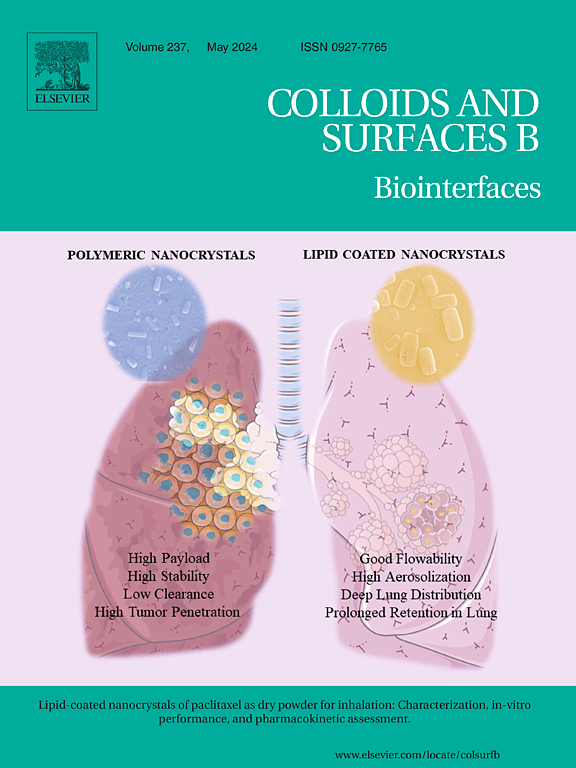α-淀粉酶/聚糖装饰金纳米棒的抗生物膜效应
IF 5.4
2区 医学
Q1 BIOPHYSICS
引用次数: 0
摘要
细菌的不断进化和生物膜的形成加剧了抗药性问题,凸显了对新型抗菌材料的迫切需求。本研究通过聚合 L-岩藻糖合成了硫醇化聚(2-(L-岩藻糖)乙基甲基丙烯酸酯)(PFEMA-SH),随后将其与α-淀粉酶共同修饰到金纳米棒(GNR)上,制备出抗菌纳米粒子复合材料 GNR-Amy-PFEMA(G-A-P)。这些纳米材料同时具有光热和酶的特性,使 G-A-P 能够有效杀菌和驱散生物膜。在近红外线照射下,G-A-P 复合材料的温度会显著升高,导致细菌细胞损伤和生物膜破坏。照射 5 分钟后,G-A-P 复合材料对浮游细菌的清除率接近 100%,成熟生物膜的生物量减少了 70.9%,生物膜内的细菌数量减少了 3.37-log。这些复合材料具有很强的抗菌活性,在清除铜绿假单胞菌生物膜方面具有很大的潜力。此外,G-A-P 能够在不使用传统抗生素的情况下减少生物膜的形成,这表明它可以为控制生物膜相关感染提供一种无抗生素替代品。本文章由计算机程序翻译,如有差异,请以英文原文为准。
The anti-biofilm effect of α-amylase/glycopolymer-decorated gold nanorods
The continuous evolution of bacteria and the formation of biofilm have exacerbated resistance issues, highlighting the urgent need for new antibacterial materials. In this study, L-fucose was polymerized to synthesize thiolated poly(2-(L-fucose) ethyl methacrylate) (PFEMA-SH), which was subsequently co-modified with α-amylase onto gold nanorods (GNR) to prepare the antibacterial nanoparticle composite, GNR-Amy-PFEMA (G-A-P). These nanomaterials exhibit both photothermal and enzymatic properties, enabling G-A-P to effectively sterilize and disperse biofilm. Under near-infrared light irradiation, the temperature of G-A-P composite increases significantly, leading to bacterial cell damage and biofilm disruption. The G-A-P composite demonstrated nearly 100 % eradication of planktonic bacteria after 5 min of irradiation and achieved a 70.9 % reduction in mature biofilm biomass, with a 3.37-log decrease in the number of bacteria within the biofilm. These composites display strong antimicrobial activity and hold great potential for the removal of Pseudomonas aeruginosa biofilm. Furthermore, the ability of G-A-P to reduce biofilm formation without the use of traditional antibiotics suggests that it may offer an antibiotic-free alternative for managing biofilm-related infections.
求助全文
通过发布文献求助,成功后即可免费获取论文全文。
去求助
来源期刊

Colloids and Surfaces B: Biointerfaces
生物-材料科学:生物材料
CiteScore
11.10
自引率
3.40%
发文量
730
审稿时长
42 days
期刊介绍:
Colloids and Surfaces B: Biointerfaces is an international journal devoted to fundamental and applied research on colloid and interfacial phenomena in relation to systems of biological origin, having particular relevance to the medical, pharmaceutical, biotechnological, food and cosmetic fields.
Submissions that: (1) deal solely with biological phenomena and do not describe the physico-chemical or colloid-chemical background and/or mechanism of the phenomena, and (2) deal solely with colloid/interfacial phenomena and do not have appropriate biological content or relevance, are outside the scope of the journal and will not be considered for publication.
The journal publishes regular research papers, reviews, short communications and invited perspective articles, called BioInterface Perspectives. The BioInterface Perspective provide researchers the opportunity to review their own work, as well as provide insight into the work of others that inspired and influenced the author. Regular articles should have a maximum total length of 6,000 words. In addition, a (combined) maximum of 8 normal-sized figures and/or tables is allowed (so for instance 3 tables and 5 figures). For multiple-panel figures each set of two panels equates to one figure. Short communications should not exceed half of the above. It is required to give on the article cover page a short statistical summary of the article listing the total number of words and tables/figures.
 求助内容:
求助内容: 应助结果提醒方式:
应助结果提醒方式:


